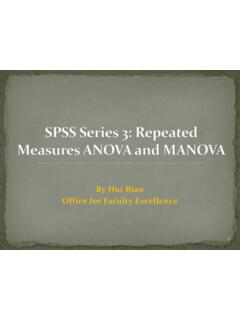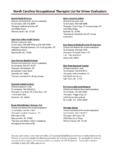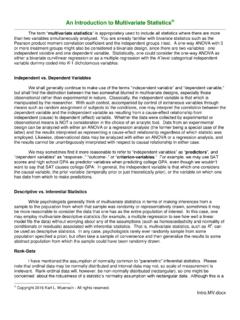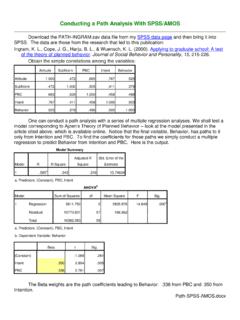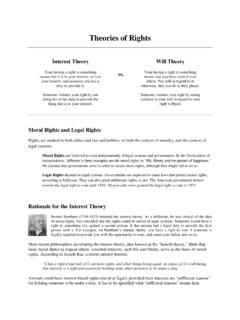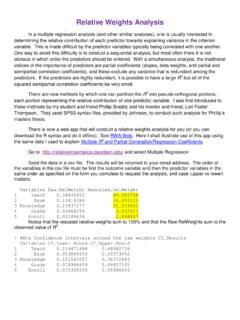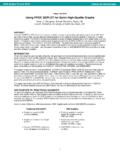Transcription of Moderated Mediation: Conditional Process Analysis
1 Moderated mediation : Conditional Process Analysis Consider the model that X has both direct and indirect (through M) effects on Y, but that the indirect and/or direct effect of X on Y is Moderated by W that is, the effects of X on Y are Conditional , depending on the value of W. There are three locations within the model where W may serve as a moderator: the direct effect of X on Y, the effect of X on M, and the effect of M on Y. Hayes (2013, pages 358 through 387) illustrates Moderated mediation with research conducted by Garcia, Schmitt, Branscombe, & Ellemers (2010). Please obtain and read the article by Garcia et al. before you continue with this lesson. The model for the Analysis that follows is Model 8 in Hayes templates. As you can see in the conceptual diagram to the right, it is Model 4 (simple mediation ) with the addition of variable W, which moderates the effect of X on M and the direct effect of X on Y. If you have not done so already, download, from Process Hayes, the data files ( ) as well as the programs ( or more recent release).
2 In folder protest you will find the data for this example, in several formats. I am going to use , which has variable names, labels, and value labels. Rather than use SPSS for the Analysis , I shall use SAS. SAS is able to import *.sav files. Boot up SAS. Open and run the macro. Import the data. During the Process of importation, name the SAS work data set protest. Open the program editor (File, New Program) and enter and run this code: Proc Contents; run; The output will give you a terse description of the imported data, including variable names and labels. If there were missing data, we would need deal with that first, creating a data file with no missing data. There are no missing data here. Although not necessary, I prefer to standardize continuous variables, so my next step is to create standardized scores. Do not that I have not standardized the two-level experimental manipulation (protest). proc contents; run; proc means; run; data protest2; set protest; SexismZ=( ) ; LikingZ=( ) ; RespapprZ=( ) ); run; In way of review, we first conduct a simple mediation Analysis : % Process (data=protest2, vars=protest RespapprZ LikingZ,y=LikingZ,x=protest,m=RespapprZ, boot=10000,model=4); The output shows that protest had a significant total effect and indirect effect on liking, but that the direct effect fell short of statistical significance.
3 2 Also in way of review, we next conduct a simple moderation Analysis . We expect that a respondent s perception of the pervasiveness of sexual discrimination will moderate the effect of protest on her perception of the appropriateness of the attorney s behavior. % Process (data=protest2, vars=protest RespapprZ SexismZ,y=RespapprZ,x=protest,m=sexismZ, quantile=1,model=1); The output shows that the Sexism x Protest interaction is significant. Quantile=1 resulted in the Conditional effects being evaluated at the 10th, 25th, 50th, 75th, and 90th percentiles of sexism. The tests of the Conditional effects show that the effect of protest increases in magnitude as amount of sexism increases. Since protest was coded 0,1, the values of the Conditional effects are differences between the two group means (Mean 1 Mean 0). Since we standardized the continuous variables, these are estimates of Cohen s d. The difference in means is not statistically significant when sexism is very low (10th percentile), but is at all of the higher tested levels of sexism.
4 We next conduct a moderation Analysis with the putative mediator held constant. Would sexism moderate the effect of protest on liking in a model that includes perceived appropriateness as a covariate? That is, does perceived pervasiveness of sexism moderate the direct effect of protest? % Process (data=protest2, vars=protest RespapprZ SexismZ LikingZ,y=LikingZ,x=protest,m=sexismZ,qu antile=1,model=1); The output shows that the Sexism*Liking interaction is statistically significant, even after holding constant the effect of the mediator, indicating that sexism moderates the direct effect of protest on liking. OK, let us now combine the mediation and moderation effects into a single model. Although we could do this with SAS or SPSS as a sequential multiple regression Analysis , we shall take advantage of Process Hayes to make it less burdensome on us. % Process (data=protest2, vars=protest RespapprZ SexismZ LikingZ,y=LikingZ,x=protest,w=SexismZ, m=RespapprZ,quantile=1,model=8, boot=10000); The output shows that the Sexism x Protest interaction is statistically significant when predicting perceived response appropriateness, and also when predicting liking (we saw these same interaction in our earlier analyses).
5 If you are also reading Hayes (2013) description of this Analysis <highly recommended beg, buy, or borrow the book>, you may have noticed that the effect sizes and t- and p-values for effect of Process are, for models including an interaction term, different than those in my Analysis . You need to keep in mind that these effects are Conditional , and while I standardized the continuous variables, Hayes did not. Consider the value of the coefficients for the Conditional effect of protesting when predicting liking. In my output b = , t = , p = .88. In Hayes output b = , t = , p = .017. This effect is Conditional , with the condition being sexism = 0. Since I standardized sexism, my effect is the Conditional effect of conflict given that sexism = the mean sexism. Since Hayes (2013) neither standardized nor centered the continuous predictors, his effect is the Conditional effect of conflict given that sexism has raw score value 0, which is lower than the lowest possible value on the sexism variable.
6 Our primary interest is with the interaction, so this is not really an issue about which to fret. Hayes (2012) conducted this same Analysis with the continuous predictors centered. If you check the results of that Analysis , you will find that my t-values match his t-values. 3 Look at the Conditional indirect effects of protesting upon liking. When sexism pervasiveness is very low (10th percentile), the indirect effect of protesting is not significant. As the value of sexism increases, the indirect effect increases in magnitude, being significant at each of the other four tested percentiles. As we saw earlier, the perceived response appropriateness of the attorney s behavior was not significantly affected by those respondents who strongly believed that sexism is not pervasive, but it was among those higher in perceived pervasiveness of sexism. This led to a parallel pattern in the indirect effect of protesting. Among those very low in sexism pervasiveness, the indirect effect was not significant, but among those higher in perceived sexism pervasiveness it was, with the magnitude of the effect (liking the attorney more when she protested than when she did not) increasing as perceived sexism pervasiveness increased.
7 Now look at the Conditional direct effect of protesting on liking. It is significant only for those very low in perceived sexism pervasiveness. As perceived pervasiveness of sexism increases from very low to very high, the effect of protest increases from a negative .55 to a positive .49. Since the effect of protest is standardized Mean 1 (she protested) minus standardized Mean 0 (she did not protest), the significant direct effect of protest among those respondents very low in perceived pervasiveness of sexism means that the direct effect of protest among those respondents is that they liked her better if she did not protest. The Indirect effect of highest order interaction quantifies and tests the indirect effect (on liking, through perceived appropriateness) of the Protest x Perceived Pervasiveness of Sexism interaction. This indirect effect is .2173 and is statistically significant (the confidence interval excludes zero). proc sgplot; series x=SexismZ y=direct/curvelabel = 'Direct Effect' lineattrs=(color=blue pattern=ShortDash); series x=SexismZ y=indirect/curvelabel = 'Indirect Effect' lineattrs=(color=red pattern=Solid); xaxis label = 'Perceived Pervasiveness of Sexism'; yaxis label = ' Conditional Effect of Protest'; refline 0/axis=y lineattrs=(color=gray pattern=ShortDash); run; 4 Moderated mediation or Mediated Moderation?
8 You will find both of these terms in the literature. Conceptually, Moderated mediation is when an indirect effect is Moderated , that is, the indirect effect varies across levels of the moderator. Mediated moderation is when the interaction between X and W is indirect (it is carried to Y through M). Hayes (2013, pages 381 through 389) explains that Moderated mediation and mediated moderation are just different perspectives on the same interaction. He makes a good argument in favor of the Moderated mediation perspective as being the more useful to adopt. References Garcia, D. M., Schmitt, M. T., Branscombe, N. R., & Ellemers, N. (2010). Women's reactions to ingroup members who protest discriminatory treatment: The importance of beliefs about inequality and response appropriateness. European Journal of Social Psychology, 40, 733-745. Hayes, A. F. (2013). Introduction to mediation , moderation, and Conditional Process Analysis : A regression-based approach.
9 New York, NY: Guilford. Hayes, A. F. (2012). Process : A versatile computational tool for observed variable mediation , moderation, and Conditional Process modeling [White paper]. Retrieved from , January, 2014. Annotated SAS Output Statistical Tests of Models That Include Mediating Variables Comparing Regression Lines From Independent Samples. Continuous Moderator Variables. Return to Wuensch s Statistics Lessons Page Karl L. Wuensch, January, 2014.
